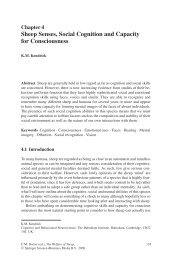Ulric Neisser
Ulric Neisser
Ulric Neisser
Create successful ePaper yourself
Turn your PDF publications into a flip-book with our unique Google optimized e-Paper software.
addressed these problems with an ingenious parallel-processing model (now justly famous)<br />
called Pandemonium. The model was all Oliver's, but it was I who suggested that we write it up<br />
for Scientific American (Selfridge & <strong>Neisser</strong>, 1960).<br />
Although machine pattern recognition was intriguing, human pattern recognition was<br />
even more so. How to study it empirically? Reaction time (RT) suggested itself as a method but<br />
seemed to have a fatal flaw: each RT includes not only the time needed to recognize the stimulus<br />
but also times for planning and executing the required responses. It was to get around that<br />
requirement that I devised a new visual search paradigm (<strong>Neisser</strong>, 1963a.) A subject scanning<br />
down a column of letters/numbers has to process each one to determine that it is NOT the target,<br />
but makes no selective response until the target itself has been reached. The scan rate (i.e., the<br />
slope of the linear function relating the position of the target to the search time) should reflect the<br />
time needed to make each of those determinations. This paradigm was an early and<br />
unsophisticated version of what would soon become known as "mental chronometry." In later<br />
studies, including several done with graduate students at Brandeis, I used it to explore other<br />
issues. The most surprising result (<strong>Neisser</strong> et al, 1963) was that well-practiced subjects can<br />
search as rapidly for any of ten targets (e.g., for a, f, h, k, m, p, u, z, 9, or 4) as for one. I took this<br />
initially counter-intuitive result as clear evidence for parallel processing in pattern recognition.<br />
The multiplicity of thought<br />
During all this time, I was profoundly ambivalent about minds and computers. On the one<br />
hand computation and programming were obviously a rich source of ideas about mental<br />
processes - a source that I was using freely myself. On the other hand my most basic intuitions -<br />
stemming from Gestalt psychology, humanistic thinking, and everywhere else - were offended<br />
by the suggestion that minds and brains are nothing but computers. Two 1963 papers reflected<br />
this ambivalence. In "The Multiplicity of Thought" (1963b), I used the contrast between parallel<br />
and serial processing to clarify familiar distinctions in the literature on thinking and problem<br />
solving: creativity vs. constraint, intuition vs. reason, productive thinking vs. blind repetition,<br />
autistic vs. realistic thinking, primary vs. secondary process. In "The Imitation of Man by<br />
Machine" (1963c) however, I listed three fundamental ways in which computer processing<br />
differs from human thinking: it does not undergo a natural course of development, is not driven<br />
by feelings and emotions, and typically addresses a multiplicity of motives at once.<br />
One of my teaching responsibilities at Brandeis during this time was a course on<br />
memory. Because the standard list-learning research was rather boring, I focused on topics such<br />
as Bartlett's notion of memory schemata and Schachtel's theory of infantile amnesia. It was to<br />
those ideas that I turned when Tom Gladwin, an anthropologist I knew slightly, invited me to<br />
address the Anthropological Society of Washington. The resulting paper, "Cultural and cognitive<br />
discontinuity" (<strong>Neisser</strong>, 1962), became a frequently cited contribution to the literature on<br />
infantile amnesia. My interest in these issues continued for more than thirty years, and eventually<br />
led to a new way of measuring the offset of that amnesia itself (cf. Usher & <strong>Neisser</strong>, 1993).<br />
Cognitive Psychology<br />
Sometime in the early '60s, all this began to jell. Perception, the span of attention, visual<br />
search, computer pattern recognition, human pattern recognition, problem solving and<br />
remembering were all interrelated aspects of information processing. Perception and pattern<br />
recognition were input, remembering was output, everything in between was one or another kind<br />
8




